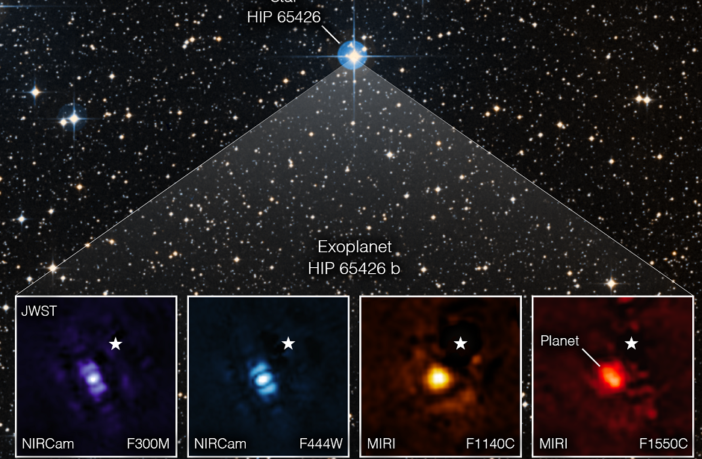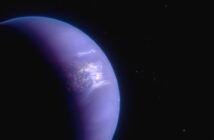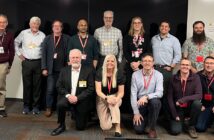For the first time an international group of researchers, including Dr Mariangela Bonavita of the OU, have used NASA’s JWST to take a direct image of a planet outside our solar system, released by NASA today.
The image of the planet, as seen through four different light filters, shows how JWST’s powerful infrared gaze can capture images of worlds beyond our solar system more quickly and easily than other instruments, pointing the way to future observations that will reveal more information than ever before about exoplanets.
The group of researchers were led by Dr. Sasha Hinkley at the University of Exeter, who commented:
“This is a transformative moment, not only for JWST but also for astronomy generally.”
The exoplanet, called HIP 65426 b, is about five to ten times the mass of Jupiter. It is young as planets go — about 15 to 20 million years old, compared to our 4.5-billion-year-old Earth. It is a gas giant, meaning it has no rocky surface and could not be habitable.
Astronomers discovered the planet in 2017 using the SPHERE instrument on the European Southern Observatory’s Very Large Telescope in Chile and took images of it using short infrared wavelengths of light.
The JWST image, taken in mid-infrared light, reveals new details that ground-based telescopes would not be able to detect because of the intrinsic infrared glow of the Earth’s atmosphere.
This first capture of an exoplanet already hints at future exciting possibilities for studying distant worlds with JWST. Since HIP 65426 b is about 100 times farther from its host star than Earth is from the Sun, it is sufficiently distant from the star that JWST can easily separate the planet from the star in the image.
Dr. Bonavita, Lecturer in Astronomy at the OU, was among the scientists that discovered HIP 65426 b in 2017 and is now a member of the collaboration behind this new image.
She spoke of how exciting a development these images are:
“These observations clearly show that JWST’s performance is exceeding even the most optimistic expectations.
“Combined with existing ground-based near-infrared data, these images provide incredible new insights on the luminosity of HIP 65426 b, and thus on its mass, confirming that JWST represents a game-changing opportunity to characterise the population of directly imaged exoplanets in greater detail than ever before.”
Aarynn Carter, a postdoctoral researcher at the University of California, Santa Cruz, who led the analysis of the images, said:
“Obtaining this image felt like digging for space treasure,”
“At first all I could see was light from the star, but with careful image processing I was able to remove that light and uncover the planet.”
Dr Bonavita went on to highlight the dedication and expertise that led to these images being a possibility:
“The team behind this discovery includes almost the entirety of the Direct Imaging Exoplanets community, and I am incredibly proud to be a part of this amazing group of researchers and colleagues from across the world.
“There is an incredible amount of work that has led to this one image, and an amazing amount of information to unpack from it.”
While this is not the first direct image of an exoplanet taken from space – the Hubble Space Telescope has captured direct exoplanet images previously – HIP 65426 b points the way forward for JWST’s exoplanet exploration.
She added:
“I think this really is a testament and a demonstration of how much we can achieve as a community if we combine our expertise and work together towards a common goal. And this is only the beginning.”



